Tea
Caddy Index

History of
caddies
Tea and Opium
Request
current list of available tea
caddies.
| |
Rosewood, tea chest inlaid with brass by Wm. Dobson,
London Circa 1810
Please click on images to enlarge or |
slide show |thumbnail index |
Reference: TC491
Description:
TC491: Rosewood, tea chest inlaid with brass tea chest having
embossed gilt brass drop ring handles to the sides made by William
Dobson. Inside there are three compartments containing two hinged
lift out tea canisters and a central well with original deeply cut crystal
sugar bowl. Circa 1810.
Origin:
Circa:
Materials:
Size: It measures inches
wide by inches deep and it is inches high
including feet: 31.6 cm wide by 16.8 cm deep by 18 cm high.
Condition:
|
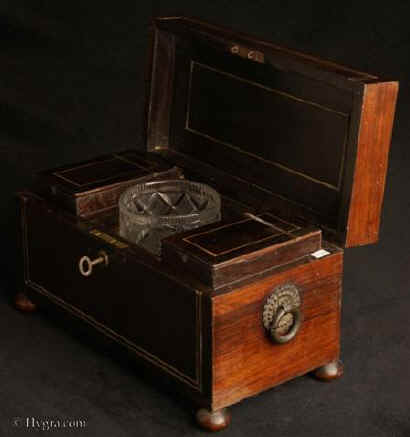
|
Please click on images to enlarge or |
slide show |thumbnail index |

|
Inside the chest are two lift-out
lidded canisters and a cut glass bowl. The lid is lined with
velvet.
This is the classic form for a
three compartment tea chest. There is a central cut crystal bowl flanked
by two hinge lidded lift out canisters.
It is interesting to compare it to a
chest from the 1790's:
Hygra:
A Harewood Three Compartment Tea Caddy circa 1790.
|
| The inlays are restrained. The escutcheon is is
small. |
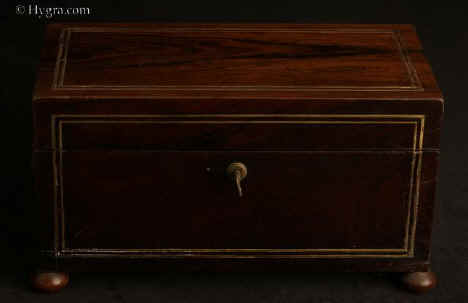
|
Please click on images to enlarge
The heavy cut crystal bowl.
The bowl is a particularly beautiful
example and original to the chest.
The bowl is
probably Irish. The tax on the weight of materials used in glass
manufacturing in England and Scotland did not apply in Ireland until
1825.
This resulted
in the setting up of glassworks in various port towns in Ireland such as
Waterford and Cork (1783).
There are little differences
in the faceting. Each was looked at as it was cut by the original artist
who is now un-named.
|
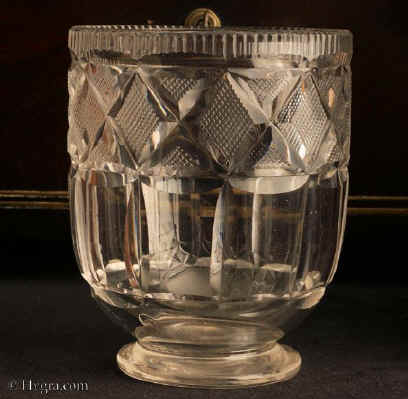
|
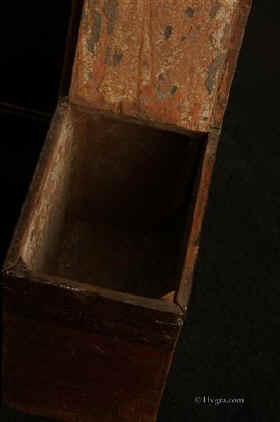
|
The lift out canisters retain some of
their original lead.
The lids have a continuous hinge are
of mahogany construction and have their lids veneered with rosewood.
They are inlaid with a brass line.
|
Please click on images to enlarge or |
slide show |thumbnail index |
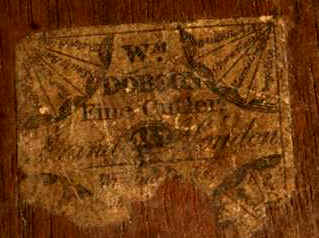
|
One of the canisters has a label indicating that the chest was made
by William Dobson.
DOBSON, W., or DOBSON, W M.:
“Hardware man Stationer and Dealer in Fine Cutlery. Strand 162
London . Pocket Books, Writing Desks Shaving & Dressing Cases
every article for fitting up the same on the Lower Terms possible.”
This firm traded from 1797-1847, from different numbers in the
Strand . They had a very interesting label with quarter paterae
designs in the four corners, listing some of their wares in each
narrow section, in addition to the list in the center of the label,
for which they were "manufacturers". The business must have
sold associated items, as much of their stock required different
disciplines. Two amusing items they list are "teeth
instruments" and "Ear Wares"! Although they did
trade into the Victorian era, all the items I have handled belonged to
their earlier period. This of course could be that they continued to
make older designs, using mahogany well into the 19th century.
|
The inside of tea-chests is complex. the carcass wood is often
as here pine Liners of mahogany edged with rounded rosewood are slipped
in. They are often not glued. For this picture I have slid out one of
the pieces of wood which separates the compartments. The well for
holding the bowl is lined with green velvet.
This space is very secret and has been used to conceal things. I have
sometimes found letters here.
|
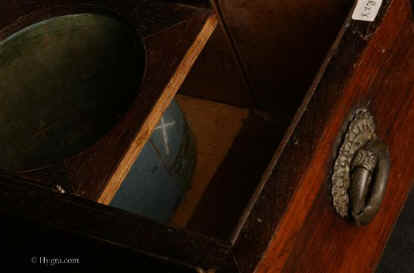
|
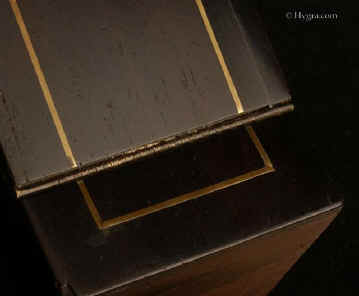
|
The lids have a continuous hinge are
of mahogany construction and have their lids veneered with rosewood.
They are inlaid with a brass line.
|
Please click on images to enlarge or |
slide show |thumbnail index |

|
The
upper part of the canisters which shows when they are in the chest
is veneered with rosewood.
|
Please click on images to enlarge or |
slide show |thumbnail index |
Please click on images to enlarge
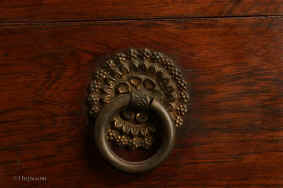
|
Detail of the embossed brass drop handle It retains some of its
original guilding..
|
Please click on images to enlarge or |
slide show |thumbnail index |
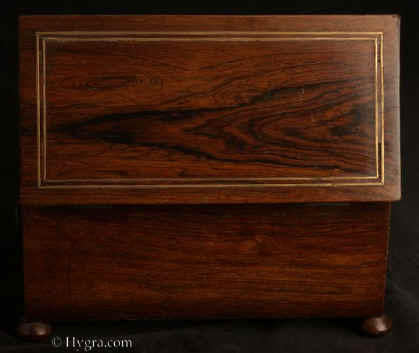
|
The figure of the rosewood of
the top is particularly attractive.
|
Please click on images to enlarge or |
slide show |thumbnail index |
Please click on images to enlarge
All text and images and linked images are ©
1999-2010 Antigone Clarke and Joseph O'Kelly. If you require any further
information on permitted use, or a licence to republish any material, email us
at copyright@hygra.com
|